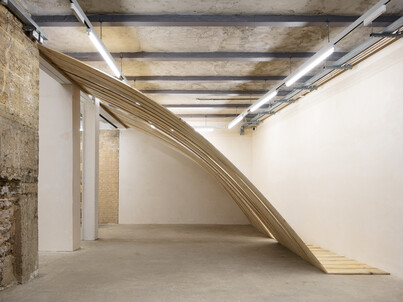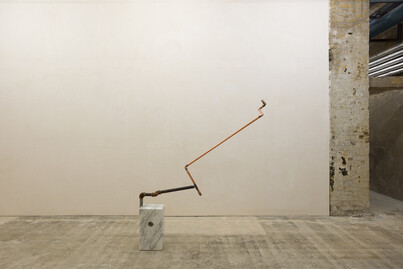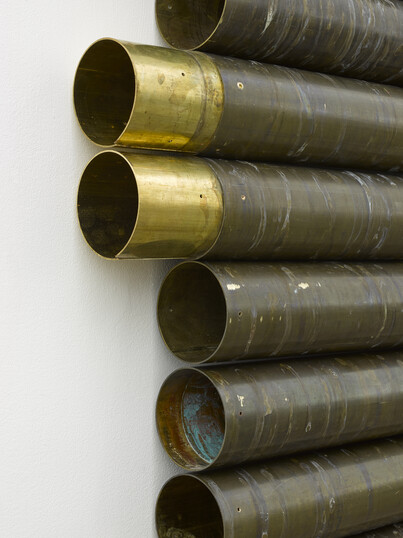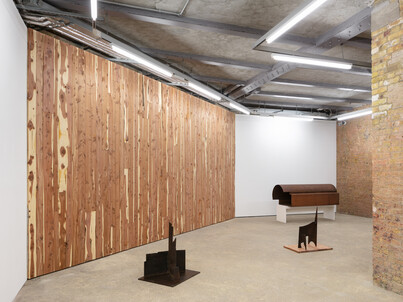Material encounters in the work of Virginia Overton
by Imelda Barnard
Reviews /
Exhibition
• 06.07.2022
The building that houses the Goldsmiths Centre for Contemporary Art in New Cross, London (Goldsmiths CCA) – a former Victorian bathhouse that was renovated in 2018 – has an industrial weight that could be considered at odds with the predominantly quiet and contemplative works of Virginia Overton (b.1971). However, there is a pleasing ambiguity to this display, which can make it difficult at times to decipher what belongs to the building and what belongs to Overton’s work. Her sculptures and installations complement the rough-hewn architecture in their shared use of industrial and construction materials. More broadly, the twenty-five works gathered here emphasise her wider, if not necessarily explicit, examination into the function or value of objects, alongside her reframing of Minimalism.
Working with timber, metal, stone, glass, plastic and piping, Overton finds potential in discarded materials, often sourcing them locally or from museum storage. For this exhibition, she has incorporated felt that has been recycled from education projects previously staged at CCA, a blue steel table found in a friend’s house in London, steel offcuts from the sculptor Anthony Caro (1924–2013) and recently decommissioned industrial materials from a British farm. The artist first used this improvisational approach for her 2012 solo exhibition at The Kitchen, New York, in which she crafted an exhibition of post-Minimalist sculptural works solely from objects and materials found on-site. Overton is also alert to the specifics of space, often teasing out the ways in which small interventions can radically transform our experience of a particular site, and revealing how works of art are framed by systems of display.
The large-scale installation Untitled (Arc) FIG.1 comprises arched whitewood beams wedged into one corner of the basement floor. The highly flexible wood relies on its own tension to alter its shape, the resultant curves drawing attention to the rigid linearity of the surrounding architecture. Yet, the slats behind the curved beams form a triangle, also revealing imperfect elements in the gallery’s structure. Such wooden interjections are not uncommon in Overton’s work: in Untitled (slant) (2013) she balanced long wooden planks at an angle against two walls at the Kunsthalle Bern, creating a stiff canopy that dramatically changed the appearance of the space and the viewer’s experience of it. In that instance, the artist was especially interested in how the wood might bend or warp over time.
At CCA it seems improbable that such a solid material should bend in this way, just as it seems unnatural for the piece of steel in Untitled FIG.2 to twist in the way it does. Interested in equilibrium and balance, Overton pushes her materials to their limits, creating Minimalist works that revel in their sensory qualities. Untitled (Arco Sculpture) FIG.3 includes a pipe salvaged from the street, which is balanced on top of a slab of Carrara marble taken from an Arco floor lamp. Overton’s juxtaposition of material central to the history of traditional sculpture and a discarded pipe challenges the very definitions of sculpture, in the same way that her dismantling of the original floor lamp undermines the functionality of an iconic piece of modern design. Alert to the history of objects and materials, this work is also, more fundamentally, a study in balance – the rusted industrial pipe seemingly weightless in contrast to the bulk of smooth marble below.
The reuse of materials is central to Overton’s practice and she often breaks down old works in order to refashion them into something new. This sense of economy can be seen in Untitled from 2015 FIG.4 – Overton’s titles have an economy all of their own – which reuses brass tubes from an outdoor sculpture commission at Storm King Art Centre, New York, in 2014. Once part of a five-hundred-foot-long linear pipe, the tubes are here mounted onto the wall, creating a sculptural painting that, situated in one of Goldsmiths’ new white cube galleries, nods towards abstraction, as well as stripping away the grandeur often associated with Land Art. The work’s history, however, remains visible in the form of marks left by birds, insects and rain FIG.5.
Overton’s work is often devised in dialogue with historical male sculptors, as in her use of Caro’s steel leftovers, which had been stored at Yorkshire Sculpture Park, Wakefield. Overton was invited by the institution to sift through the piles of offcuts and she chose pieces that she could amalgamate with other materials to make new works. What is remarkable is the extent to which her pieces resemble Caro’s own sculptures, so recognisable are the shapes and forms. Such structures speak to the historical life of materials and the long-lasting imprint of the artist’s hand. Untitled (rumination) FIG.6 delicately assembles fragments of Caro steel, the rusty imperfections clearly visible, and places them on top of a fluffy sheepskin, the softness of this rural material contrasting the weather-beaten metal. While the sheepskin can be interpreted as a partial plinth, a collection of smaller sculptural works also made using Caro steel include more explicit references to the artist’s modes of display. Some are perched on plinths reused from past CCA exhibitions, whereas others rest close to the floor on small blocks of cedarwood in reference to Caro’s radical disavowal of the plinth and his preference for bringing sculpture into contact with the space of the viewer FIG.7.
Not all of the works on show have an inherent quietness. For Untitled (chime for Caro) FIG.8, Overton arranged the steel fragments according to weight, suspending them from an industrial gantry, sourced from a farm, alongside a row of aluminium pipes. Viewers are encouraged to play the interactive sound sculpture, and this participatory element speaks to the performative aspect of Overton’s practice, and her reliance on the viewer to activate space. Accompanying an immersive installation in the darkened tank gallery is a two-hour reworking of Richard Strauss’s tone poem Also sprach Zarathustra, the throbbing sound of which contrasts with the disco effect created by two sculptures made using corroded Caro steel and decorated with mirror tiles. Inspired by Joan Baez’s 1975 song Diamonds and Rust, this adopted title is an apt description of Overton’s ability to reanimate the scrapyard.
The walls of the basement gallery at CCA, which houses the smaller sculptures using Caro material, are partially clad in planks of red cedar cut from Overton’s family farm in Tennessee, where she lived before completing an MFA at the University of Memphis in 2002 and moving to New York. A reference to the American South, the wood’s distinctive smell holds particular resonance for Overton, conjuring as it does ideas of home. The material is something of a motif in her work – for example, in the intimidating wall of red cedar planks that make up Untitled (Juniperus virginiana) (2013) – its natural quality often providing, as it does here, a contrast to her predominantly Minimalist, industrial aesthetic. As a result, Overton can be read as a Southern artist, a regional label that she resists, given the responsive and site-specific nature of her work.1
There is a telling moment in an interview between Overton and the curator Fabrice Stroun on the occasion of the artist’s Kunsthalle Bern exhibition in 2013. Attempting to unpick her thoughts on the value of found objects, Stroun says: ‘But a piece of wood looked at in a space consecrated for art is no longer the same piece of wood found on the side of the road’. Overton responds, ‘Actually, I think they are the same thing’.2 For the critic Tim Griffin, writing recently in Artforum, this statement sees Overton kick ‘the readymade’s legacy to the curb’ in its denial of the aura a gallery context bestows on an object.3 Overton asserts that an object does not shed its past lives once in a white cube setting, but instead that it remains the same irrespective of context. ‘The object is never fixed or resolved, with meanings foreclosed; it is always inherently ambiguous [. . .] there is no transformative moment moving into the gallery but instead a sedimentary accrual that is bound to continue indefinitely’,4 as Griffin puts it. Overton embraces the ambiguities inherent in her work, viewing her objects as sites of continuous transformation.











